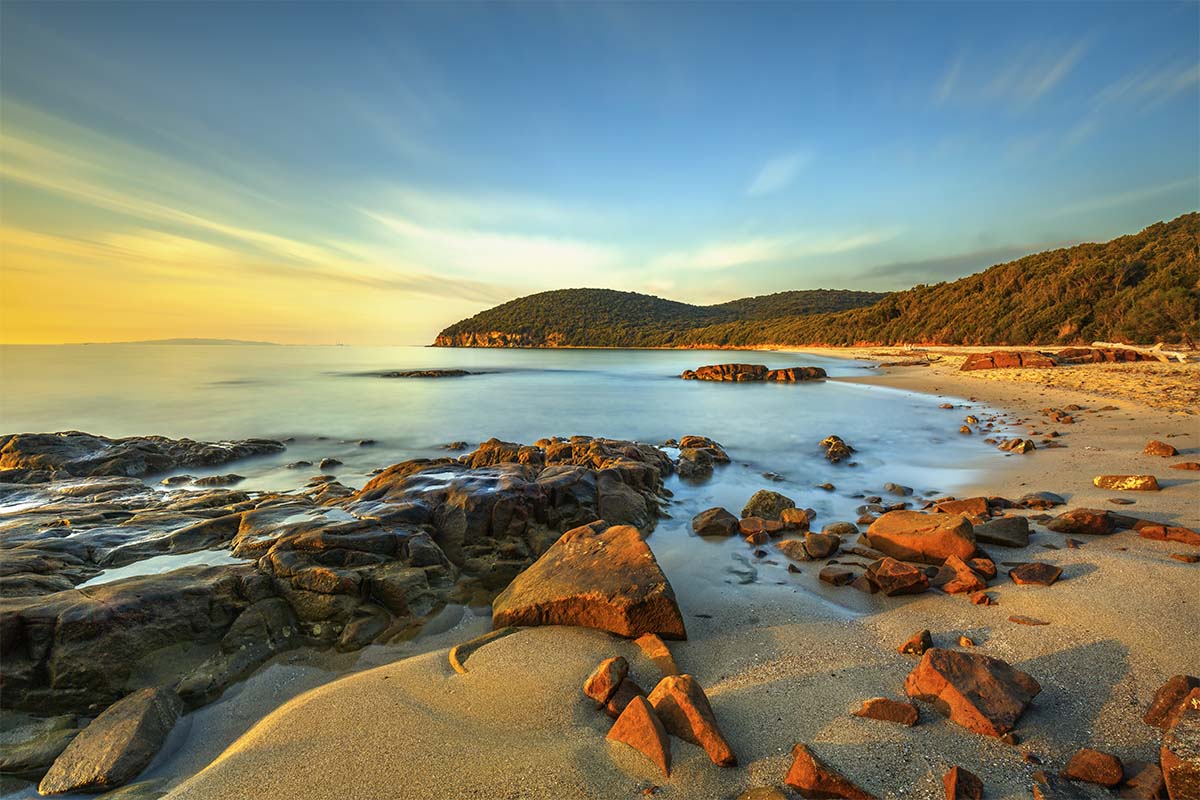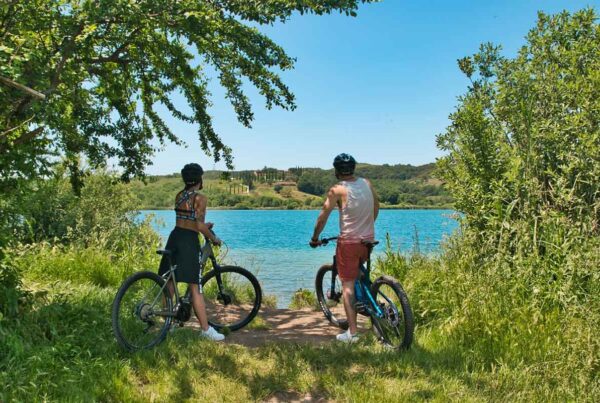The Tuscan Maremma has at least 160 km of coastline lined with beautiful beaches, picturesque bays, a colourful and rich seabed, and picturesque islands.
The waters are among the clearest and cleanest in Italy, so it’s no surprise they have received numerous accolades.
Public beaches alternate with fully equipped bathing establishments complete with all services ensuring comfort and relaxation for beachgoers.
The marinas make it simple to get around by boat to admire parts of the coast that would otherwise be difficult to reach.
Many of the locations are especially suitable for families with children thanks to the characteristics of the beaches, clean waters, and services offered.
Blue Flag beaches of the Tuscan Maremma
The FEE Blue Flag is further proof of the excellent quality of the Tuscan Maremma sea, and high calibre of the services provided.
Let’s find out which beaches fly this important flag:
- Grosseto: with the Marina di Grosseto and Principina a Mare beaches;
- Follonica;
- Castiglione della Pescaia: with the Pian d’Alma, Casetta Civinini, Piastrone Punta Ala, Rocchette, Roccamare, Casa Mora, Riva del Sole, Capezzolo, and Ponente beaches.
The FEE Blue Flag is awarded by evaluating compliance with 33 criteria relating to different areas: Environmental education and information, Water quality, Environmental management, Services and safety.
The most beautiful beaches in Tuscany
While the Maremma boasts 3 municipalities that have been awarded the FEE Blue Flag, Tuscany as a whole has received 19, placing it second in the list of regions with the most awards, just behind Liguria.
But which are the most beautiful beaches in Tuscany?
Let’s take a look together:
- Cala del Gesso – Monte Argentario (GR): can be reached by sea or on foot via a nature trail. It is a small, completely wild pebble beach washed by emerald seas;
- Feniglia – Orbetello (GR): unspoiled and surrounded by nature, it is near Orbetello and distinguished by a lengthy stretch of sand at least 7 km long. The “tombolo” connects the Ansedonia hill to Monte Argentario. The sea is crystal clear and the sand is soft and golden;
- Spiagga delle Rocchette – Castiglione della Pescaia (GR): this is a section of coastline of the so-called “Switzerland of the Maremma”. The sandy beach, shallow waters, equipped bathing establishments and clean sea make it the perfect location for families. Its name is derived from the Forte delle Rocchette, an ancient watchtower;
- Cala Violina – Scarlino (GR): this stunning beach is part of the Bandite di Scarlino Nature Reserve and is situated on the section of coast between Follonica and Punta Ala. The name comes from the sound made by the small quartz grains making up the cove, when they are stepped on. After parking your car in the car park with 150 spots, it’s a 1.5 km walk;
- Torre Mozza – Piombino (LI): a long, white beach with crystalline water. The beach takes its name from the similarly named 16th-century tower. It has a seabed rich in natural treasures all to be discovered, and is lapped by crystal-clear water;
- Spiaggia delle Cannelle – Isola del Giglio (GR): one of the Tuscan Archipelago’s most beautiful beaches. The sea is transparent, flecked with blue, only 100 metres long and characterised by tiny quartz grains;
- Spiaggia di Sansone – Isola d’Elba (LI): the white seabed under the calm, clear waters is one of its most special characteristics. It is one of the island’s most picturesque beaches and a perfect location for divers thanks to the seabed’s abundance of caves, ravines and rare fish;
- Cala Giovanna – Isola di Pianosa (LI): this idyllic cove is distinguished by the ruins of a Roman villa and is the only beach on Pianosa where stopping and bathing is allowed;
- Baia del Quercetaro – Castiglioncello (LI): this fraction of Rosignano Marittimo offers an enchanting beach with fine sand, smooth rocks and Mediterranean maquis. A half-moon shaped location, sheltered from the winds and ideal for people of all ages;
- La Lecciona – Viareggio (LU): a public, sandy beach part of the Migliarino, San Rossore, Massaciuccoli Regional Park and situated halfway between Viareggio and Torre del Lago. It is the largest beach in all of Versilia. It offers golden sand dunes and crystal-clear seas.
The best beaches in the Maremma
The Tuscan Maremma is full of unique and characteristic beaches, many of which are found inside nature reserves and are ideal for both families with young children and those who enjoy sports and fun.
Let’s see where to find the best places to go to the beach in Maremma:
- Gulf of Follonica: here we have both a city beach with paid bathing establishments, and wilder, more natural beaches, particularly in Torre Mozza. A long stretch of fine white sand washed by crystal-clear seas;
- Spiaggia Acqua Dolce – Porto Ercole: this is a pebble beach situated along the coast of Monte Argentario. The water is very clean, the seabed stony at first and sandy a few metres in;
- Cala Violina: this beach is in the municipality of Scarlino, north of Punta Ala and south of Follonica, surrounded by Mediterranean maquis. It is located in the heart of the Maremma coast and can be reached on foot along a 1.5 km path. The surrounding headlands are breathtaking, and the water is clear as glass. The name comes from the sound made when walking on the sand;
- Spiaggia delle Rocchette: south of Punta Ala, in the municipality of Castiglione della Pescaia. The name derives from the numerous cliffs overlooking the sea where people can sunbathe and dive in the clear waters. It has a selection of bathing establishments and stretches of public beach;
- Spiaggia della Feniglia: located in the municipality of Orbetello, this beach is a good 7 km long. It is one of the three strips of land connecting the mainland to Monte Argentario. The beach is sandy and the seabed shallow. Its characteristics make it suitable for families with children. The Femiglia Natural Park is just behind the beach;
- Spiaggia delle Marze: this public beach is about 6 km long and situated north of Marina di Grosseto on the road to Castiglione della Pescaia. It is a public beach with high dunes and typical vegetation that is popular among outdoor enthusiasts and nature lovers;
- Cala di Forno: a small beach in the Maremma Park surrounded by untamed nature. It can only be accessed by purchasing a ticket at the Alberese visitor centre;
- Spiaggia Acqua Dolce – Porto Ercole: this area can be reached via a paid walkway. The beach is in the municipality of Grosseto, just a few kilometres from Alberese. It is a public beach open to everyone, wild, but also well-kept;
- Punta Ala: a mix of paid and unpaid bathing areas. The beach is in the municipality of Castiglione della Pescaia and lapped by crystal-clear waters. Many Etruscan and Roman artefacts from ancient shipwrecks were recently discovered during underwater archaeological excavations;
- Capalbio: also known as “the last beach” because it is the last Tuscan beach before crossing over into Lazio. It has plenty of bathing facilities, restaurants and camp sites, and is well-kept and maintained.
Sports and excursions in the Maremma sea
The Maremma is a particularly popular holiday destination for water sports enthusiasts thanks to its mild climate.
Sailing, windsurfing, kitesurfing, water skiing, sport fishing and diving are popular pastimes for both tourists and locals.
Divers will undoubtedly enjoy the thrill of exploring the most stunning seabed in the entire Maremma, which lies between Monte Argentario and the islands of Giannutri and Giglio.
We are talking about one of the most evocative areas in the entire Mediterranean, both in terms of the marine life and the seabed with its crystal-clear waters, Neptune grass meadows, vast expanses of sea fans, caves, wrecks, shoals, rock walls and canyons.
Boat excursions along the Maremma coast with stopovers at Argentario, the islands of Giglio and Giannutri, and the Tuscan Archipelago National Park, allow visitors to explore the area form a different perspective.








